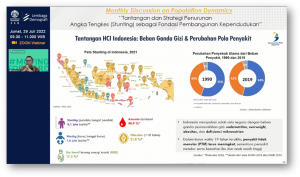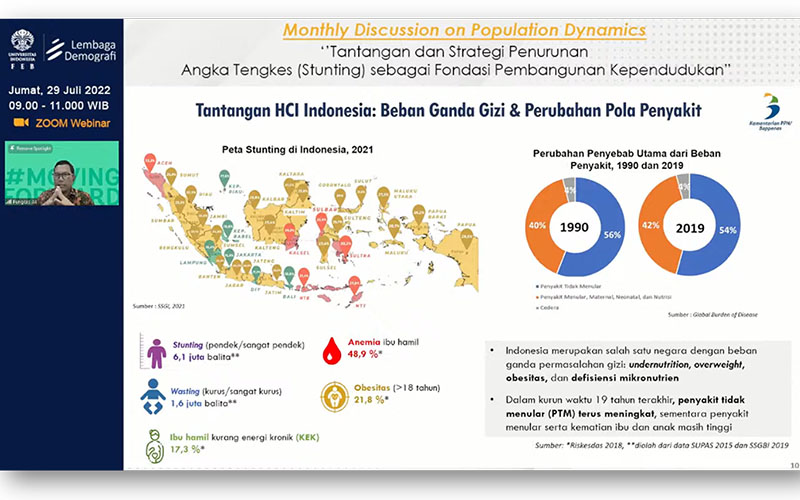Monthly Discussion LD FEB UI: Indonesia’s Stunting Rate Still Second Highest After Papua New Guinea in Asia-Pacific
DEPOK – (29/7/2022) The Demography Institute of the Faculty of Economics and Business, University of Indonesia (LD FEB UI) has a new program entitled population dynamics discussions with various themes held every month. This Monthly Discussion is expected to be a means to strengthen the network between stakeholders, population experts, and researchers. The third discussion session was held on Friday (29/7), with the theme “Challenges and Strategies for Reducing Stunting Rates as the Foundation of Population Development.”
This discussion is expected to be a form of community service from LD FEB UI as one of the tri dharma of higher education to jointly formulate, analyze, and provide policy recommendations to the parties, as well as to provide information, updates on various issues or problems and discuss policy strategies with the parties.
The discussion forum moderated by Dr. Abdillah Ahsan presented Ir. Siti Fathonah, MPH, as a Family Planning Field Officer and Principal Expert from BKKBN (representing the Head of BKKBN as the Chief Executive of the Central Stunting Reduction Acceleration Team); Prof. Dr. drg. Sandra Fikawati, M.P.H. as Professor of FKM UI in Nutrition and Health; Pungkas Bahjuri Ali, S.TP, MS, Ph.D., as Director of Public Health and Nutrition of the Ministry of National Development Planning/Bappenas; dr. Elvina Karyadi, M.Sc., SpGK, Ph.D. as Senior Health Specialist of World Bank Indonesia.
At the beginning of the discussion, Ir. Siti Fathonah, MPH stated that based on the Indonesian Nutrition Status Survey (SSGI) results, the prevalence of stunted toddlers in Indonesia is 24.4%. Although the stunting rate has experienced a downward trend from 2018 to 2021 by approximately almost 6%, Indonesia still has to catch up with Indonesian President Joko Widodo’s target of 14% by 2024.
Siti explained that NTT is the province with the highest stunting rate at 37.8%, and Bali is the lowest province at 10.9%. Various forms of policies have been planned and refined until finally, it came to Presidential Regulation No. 72 of 2021, entitled “RAN PASTI” (National Action Plan for the Acceleration of Stunting Reduction), which began to strengthen convergence through data provision, family assistance from Catin (Prospective Bride) to children aged 24 to 59 months, surveillance of families at risk of stunting, and auditing stunting cases. Some of these efforts were made considering that the stunting rate in Indonesia is still the second highest after Papua New Guinea in Asia-Pacific.
The next speaker, Prof. Dr. drg. Sandra Fikawati, M.P.H., explained some of the best practices in reducing stunting in countries that have succeeded in reducing stunting relatively quickly, namely Thailand, Vietnam, Brazil, and Peru.
Some lessons learned that could be innovations in reducing stunting include sustainable political commitment, multisectoral activities needed, focus on interventions based on evidence of success, increased access to quality health services, and mobilization and community involvement for service delivery and utilization.
On this occasion and continuing the material of the previous speaker, Prof. Sandra also explained several specific intervention programs to reduce stunting, starting from catin (including adolescent girls and pre-pregnant mothers) through the consumption of blood supplement tablets to overcome anemia; then pregnancy checks, consumption of blood supplement tablets and PMT (supplementary feeding) for pregnant women who experience SEZ (Chronic Energy Deficiency); and the importance of exclusive breastfeeding for infants 0-6 months and animal protein PMT for infants/children aged 6-23 months. Related to this, two essential intervention packages are the school-based approach and the mixed approach in the late adolescent group (15-19 years) involving the media community and the health system.
Furthermore, Pungkas Bahjuri Ali, S.TP, MS, Ph.D., explained that bringing quality, productive, and technology-savvy human resources is Indonesia’s vision in 2045 to become the country with the highest income and the world’s largest economy. Unfortunately, this is impossible to achieve if stunting is still a significant problem that overshadows human resources in Indonesia.
Stunting can occur in various family profiles, but generally, stunted children are more common in families with families who do not finish primary school, mothers who are too young, and children born with LBW. In this case, the poor tend to have a higher prevalence of stunting than the poor, and almost 4-54% of the Indonesian population cannot reach the minimum nutritious food needs. Mr. Pungkas explained that social assistance could be a crucial strategy to improve the nutrition of beneficiary families with 1,000 HPK.
The last speaker, Dr. Elvina Karyadi, M.Sc., SpGK, Ph.D., added to the exposure of the previous speakers, namely based on the latest Indonesian Toddler Nutrition Status Survey (SSGBI) related to the underweight rate, especially acute malnutrition tends to increase during Covid-19. This case should be an essential concern because it indicates that Covid-19 affects the nutritional status of toddlers. What is feared from repeated underweight cases is the potential for stunting problems to arise.
Doctor Elvina emphasized the lesson learned from Peru, which managed to reduce stunting by 15% points within eight years. The most emphasized point is the importance of multisectoral convergence between health services, quality nutrition, adequate care and stimulation, nutritious food safety, water, and sanitation. The World Bank initiated the INEY Program (Investing in Nutrition & Early Years Program) to facilitate these convergence efforts.
For further information, please contact:
Finda Prafianti, S.Sos.
Corporate Secretary Demography Institute FEB UI
corsec@ldfebui.org
08119692610



